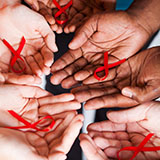Partner Services Interventions Increase HIV Testing and are Cost-effective
 The Community Preventive Services Task Force (CPSTF) recommends partner services interventions to increase HIV testing. A systematic review of evidence from 27 studies shows interventions are effective at identifying and testing sexual and needle-sharing partners of persons newly diagnosed with HIV infection. This improves health for population groups disproportionately affected by HIV and supports the Ending the Epidemic in the U.S. plan from the Department of Health and Human Services. A separate systematic review of economic evidence from six studies shows partner services interventions to increase HIV testing are also cost-effective.
The Community Preventive Services Task Force (CPSTF) recommends partner services interventions to increase HIV testing. A systematic review of evidence from 27 studies shows interventions are effective at identifying and testing sexual and needle-sharing partners of persons newly diagnosed with HIV infection. This improves health for population groups disproportionately affected by HIV and supports the Ending the Epidemic in the U.S. plan from the Department of Health and Human Services. A separate systematic review of economic evidence from six studies shows partner services interventions to increase HIV testing are also cost-effective.
Results from the review showed a median of 2.4 index patients were interviewed to identify one sexual or needle-sharing partner. Once identified, 59.8% of partners were notified, 55.1% of those notified were tested for HIV, and 14.6% of tested partners were diagnosed with HIV infection. And those diagnosed were more likely to be linked to care within 90 days of diagnosis than were people who did not receive partner services.
What are Partner Services Interventions?
HIV partner services are offered to people with a diagnosis of HIV infection (index patient) and their sexual or needle-sharing partners. Interventions include notification of possible exposure, HIV testing, and related services. Programs also offer prevention counseling, HIV testing, linkage to medical care, and referral or linkage to other services.
Partner notification is an essential component of partner services. Trained personnel interview patients diagnosed with HIV infection to learn about their sexual or needle-sharing partners and make plans to confidentially notify partners of their potential exposure to HIV. Partners may be notified in person or remotely (e.g., telephone, email, text) through provider referral, self-referral, third-party referral, or a combination of these approaches.
Why is this important?
Ending the HIV Epidemic in the U.S. is the operational plan developed by agencies across the U.S. Department of Health and Human Services to pursue the goal to reduce new HIV infections by 75% in 5 years and 90% in 10 years. For the United States to achieve these goals, steps must be taken to diagnose people living with HIV as early as possible, link them to care, and start treatment to achieve and maintain viral suppression to prevent transmission to others. Testing for HIV is the first step.